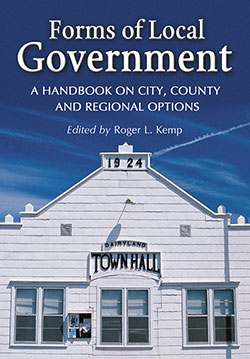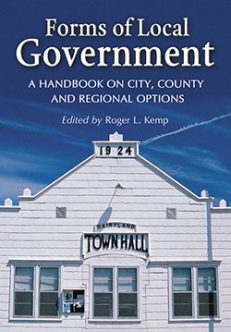Forms of Local Government
A Handbook on City, County and Regional Options
$49.95
In stock
About the Book
This handbook provides a comprehensive overview of the various forms of government below the state level now in use in the United States of America. It sorts through the traditional commission, mayor-council, strong mayor, and council-manager models for counties, cities, townships and school districts. The book also treats those entities that transcend the traditional boundaries of cities and counties, including the evolving residential community associations and regional government structures. Further examination is given to sub-metropolitan districts such as municipalities and boroughs. A clear basis for assessing the productivity and effectiveness of the various forms of government is provided by 38 contributors in 45 essays, considering such issues as revenue, privatization, strategic planning, suburbanization, city-county consolidation, and other urban and rural topics. The proper roles for elected and appointed officials in all models are explored.
About the Author(s)
Bibliographic Details
Edited by Roger L. Kemp
Format: softcover (7 x 10)
Pages: 398
Bibliographic Info: diagrams, tables, index
Copyright Date: 2007 [1999]
pISBN: 978-0-7864-3100-7
Imprint: McFarland
Table of Contents
Preface 1
PART I : INTRODUCTION
1 Overview of Local Governments 5
2 The Structure of Local Governments 11
3 Evolution of National Civic League Policies 27
4 Sharing the Load of Governance 35
5 The Responsible Public Executive 41
PART II : CITIES
6 Forms of Local Government in American History 47
7 Contemporary Choices for Citizens 63
8 The Council-Manager Form of Government 69
9 Understanding the Role of the Mayor’s Office 75
10 Theory v. Reality with the Council-Manager Plan 82
11 An Assessment of the Council-Manager Plan 89
PART III : COUNTIES
12 Overview of County Governments 95
13 Organization of County Governments 101
14 The Suburban County 117
15 The Rural County 122
16 County Leadership Models 126
PART IV : REGIONS
17 Regional Governance and the Post-Industrial Economy 135
18 Regional Cooperation: Global Competitiveness and Urban Reform 144
19 From Metropolitan Cooperation to Governance 151
20 The Evolution of Regional Planning 159
21 Models of Regional Governance 172
22 Regional Governance and Regional Councils 186
PART V : CITY STUDIES AND TRENDS
23 Contemporary Trends in Municipal Government Structures 195
24 Form and Adaptation of Municipal Government Structures 207
25 Fractured Cities: When Power Becomes Fragmented 220
26 What to Do When Reformed Government Doesn’t Work 226
27 Writing Home-Rule Charters 231
28 The Benefits of the Council-Manager Plan 236
PART VI : COUNTY STUDIES AND TRENDS
29 County Government: A Century of Change 245
30 Counties in Transition: Issues and Challenges 255
31 City-County Consolidation: A Matter of Efficiency? 260
32 City-County Consolidation: Learning from Failure 267
33 The Evolutionary Consolidation Model 272
34 A Report to the Charter Review Board 280
PART VII : REGIONAL STUDIES AND TRENDS
35 The Case for Regional Cooperation 297
36 Regions in Action: Regional Governance and Global Competitiveness 309
37 Regionalism: The New Geography of Opportunity 319
38 The Metropolitan Council: Integrating Planning and Operations 333
39 Revenue Sharing and Urban Growth 339
PART VIII : THE FUTURE
40 The Lure of the Strong Mayor 347
41 Beware of the Lure of the Strong Mayor 353
42 Good Government, Bad Government 358
43 County Government in the 21st Century 365
44 Regional Excellence in the 21st Century 373
45 Hope for “Suburbanitis” 377
About the Contributors 381
Index 383
Book Reviews & Awards
- “highly recommended”The Midwest Book Review
- “thorough overview of the various forms of local government”—Booklist
- “a good resource”—ARBA
- “valuable…an excellent reference source…non-technical and does not require any prior knowledge of the subject matter”—Government Finance Review
- “offers an overview of the various forms of government below the state level…considers urban and rural issues such as revenue, privatization, strategic planning, suburbanization, and city-county consolidation”—Reference & Research Book News





